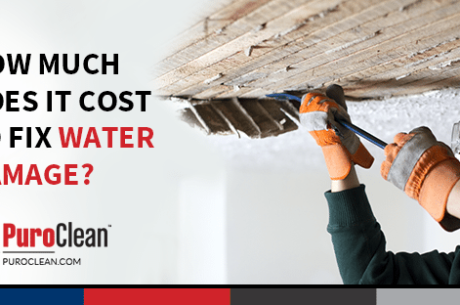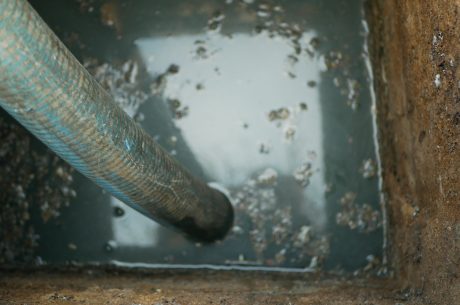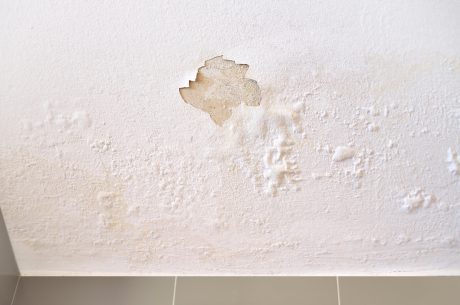Surviving Spring Thaw and Flooded Basements
Spring snowmelt in Matawan and around Monmouth County, NJ can turn your basement into a flood zone fast. Rising groundwater and surface water runoff put your home at risk—are you ready?
Not sure where to start? If basement flooding happens—whether from thawing snow or even things like heavy rain, a burst pipe, or clogged drains—our Guide to Basement Flooding has you covered. Learn about safety steps, quick actions, DIY water removal, and professional restoration.
What’s Covered:
- Flood Prevention
- Guide to Basement Flooding
- Be Prepared
- What to do first after a flood
- Get to know your sump pump
- Basement flood cleanup
- Professional water extraction and repair
Spring Thaw Water Damage and Flood Prevention Tips
Along with snowmelt, foundation drains can fail, sump pumps can malfunction, and water can seep through foundation cracks or a basement window–all leading to flooding or water damage. Luckily, most of these issues can be prevented or mitigated.
Here are some tips to get your home ready for the spring thaw:
Improve Drainage Around Your Home
- Grade the soil away from your home’s foundation to direct water away.
- Ensure downspouts extend at least six feet from your home to prevent water buildup near your basement.
- Keep gutters and downspouts clear of debris and ice to maintain proper water flow.
Protect Basement Windows and Entries
- Ensure window wells have proper drainage to reduce the risk of leaks.
- Install window well covers to stop water from pooling.
Monitor for Water Issues
- Invest in a water alarm and flood sensors, especially if you have a sump pump or live in an area with a high water table. These devices provide early warnings of potential flooding.
Safeguard Your Belongings
- Store valuable items on higher shelves or keep them out of the basement entirely.
- Use plastic storage bins instead of cardboard, which absorbs water and promotes mold growth.
Consider Additional Flood Prevention Measures
- If you’ve had basement flooding before, consider installing a French drain and sump pump system.
- Ensure your French drain has a slight slope for effective drainage.
- Prepare in winter by learning how to prevent winter water damage
Your Guide to Basement Flooding
How to Prepare for a Flood
Have an Emergency Plan
If you live in a flood-prone area, preparation is key. Start by making an emergency plan that includes essential items you’ll need if you need to evacuate quickly. You can find a basic disaster supplies list at https://www.ready.gov/kit.
Check Your Insurance
Home insurance policies don’t include flood insurance. Ask your insurance agent about adding coverage if you live in an area that can flood.
Also, review your homeowners insurance to see if it covers sewage backup, sump pump failure, or water damage from burst pipes or foundation cracks.
Standard policies often exclude basement flooding, so flood insurance may be worth considering. Your insurance company can help determine the right coverage for your needs.
Have a Generator
Install a whole-house generator or purchase a portable electrical generator. These can provide your house with a backup source of electricity in an emergency. Never use portable generators inside or near windows or ventilation systems.
Ensure Backflow Prevention
A backflow prevention valve is a crucial tool to help protect your basement from flooding, especially during heavy rain or sewer system overloads. This valve is installed in your home’s main sewer line and is designed to let wastewater flow out, but it prevents anything from flowing back in.
First Things to Do in the Event of a Flood
- Check your home for structural damage and make sure it’s safe to enter. If the structure is damaged, do not go inside.
- Turn off the electrical supply to the basement. If you have a flooded basement, turn off the power immediately. Use a dry wooden stick or wear rubber-insulated gloves to access the breaker. Water and electricity are a dangerous combination. If water reaches outlets, pipes, or appliances, there’s a risk of electrical shock.
- Avoid direct contact with floodwater. It can be electrically charged and contain dangerous contaminants like lead, mercury, and microorganisms. (Again, wear proper personal protective equipment!)
- Document Everything! Take photos and videos of the flood-damaged areas and specific items. Also, keep a detailed list of the damaged items. This will help you later with the insurance claims process.
- Contact your insurance company right away if your basement floods. An adjuster will assess the damage and begin the claims process, but they typically arrive after water removal is complete.
- Start the water remediation process immediately to prevent further damage—waiting will only make the situation worse.

Get to Know Sump Pumps
A sump pump helps defend against basement flooding. This device can detect and remove excess water before it causes serious damage. These pumps are powered by electricity, water pressure, or batteries.
Battery backup units generally work six to eight hours before the battery dies. However, check your operation manual for specifics for your unit.
Water pressure backup pumps work without a battery or electricity but run on water supply and pressure. The downside to the water pressure model is that your water bill will be high, so make sure that it is only used as a backup.
Sump Pump Failure
Inspect and test your sump pump monthly and before storms to make sure it’s working properly before a storm hits. Check for debris, test the float switch, and confirm your backup system is ready.
Here are some reasons that cause sump pump failure.
- Overheating
- The float gets stuck so the unit won’t turn on
- The battery has run out of life (for battery backups)
- The circuit breaker or the outlet has tripped (for units that use electricity)
- Plugging other devices into the same outlet, overloading the circuit
Flooded Basement Cleanup
After taking immediate steps following a flood, use these tips to safely clean your flooded basement.
Is it Safe to go into a Flooded Basement?
Safety should always come first when dealing with a flooded basement. Floodwater can pose serious risks, including electrical hazards, mold exposure, and harmful bacteria or chemicals from sewage or contaminated water.
Before entering, turn off the electricity to the basement at the breaker—never step into standing water if the power is still on.
Wear proper personal protective equipment (PPE). This includes waterproof boots, gloves, and disposable coveralls. Also wear a face mask or respirator to protect against contaminants.
If you’re unsure whether it’s safe, get a professional assessment before starting cleanup.
If the flood involves a sewer backup, contaminated items, or possible structural damage, professional help is essential. Experts have the right equipment and training to safely remove hazards and restore your home. When in doubt, prioritize safety and call for professional help.
Remove the Water
The first step is to remove the water. If using a wet/dry vac, remove the paper filter first. If there is a lot of water, you may need to rent a professional-grade pump. Most pumps only work if the water level is greater than two inches. It’s best to put the pump in the sump pump pit (if you have one) so you can remove more water from the floor.
If you have a finished basement, the water covers most of your floor, or you have health issues, call a professional. A storm’s damage typically affects more than the average homeowner can see.
To properly dry your basement, specialized equipment and moisture meters are used to determine the specific needs of the home or commercial space.
Sewer System Backups
Heavy rains or a large snow melt can cause the public sewer system to back up into your basement from your main drain, toilet, sink or shower. A sewer backup is not something you can just mop up because of safety concerns. Homeowners should use extreme caution when cleaning due to the contaminated water. Best case, leave the cleanup to the professionals with training and the right equipment.
- You might enjoy this Facebook video on Sewage Backup Prevention.
Dealing with Contaminated Items
It’s important to inventory and take photos of personal belongings that cannot be saved. Porous items like sofas, pillows, cardboard, and particle board must be thrown out when contaminated by flood water or sewage backups.
Non-porous items like plastic containers, metal desks or shelving units can be cleaned with a disinfectant cleaner.
Inspect for Damaged Structures
After removing the water covering your basement floor, it’s time to determine what has been affected. This includes moisture-metering walls, floors and ceilings that may have been affected by the flood. If the sewage or floodwaters have reached your sheetrock, carpeting, laminate flooring, or trim, they should be removed.
Clean and Disinfect
Use a stiff-bristle brush and heavy-duty cleaner to remove dirt and pathogens from the concrete floor, stairs, and walls. Once cleaned, apply a disinfectant to prevent mold growth.
The Drying Process – Will a Flooded Basement Dry on its Own?
A flooded basement will not dry properly on its own. If not properly dried, dampness can lead to mold growth and structural damage.
If the flooding is minor, you can help dry the space by improving air circulation. On dry days, open windows and use fans.
If it’s humid outside, keep windows and doors closed while running fans and dehumidifiers. Position fans to direct airflow over affected areas, like flooring or exposed stud walls.
Dehumidifiers remove excess moisture, while fans circulate air to speed up drying. Acting quickly helps prevent long-term damage and mold.
Inspect for Mold
If a basement has not been appropriately dried after a water event or you have high humidity levels in your basement, mold can grow.
Some common signs include a musty smell, discoloration on walls and ceilings, and spotting on your joists or trim.
If you find these telltale indicators, contact a professional mold remediation expert.
Professional Help for Flooded Basement Cleanup
Whether your basement has flooded due to snowmelt, excessive rain, plumbing backup, a pipe break, or other causes, PuroClean is ready to provide basement cleanup services.
Our technicians are trained and certified to handle emergencies like basement flooding repair, mold removal, sewage cleanup and water extraction and damage restoration.
Contact PuroClean of Matawan. We serve Matawan and our neighbors in nearby Monmouth County, like Old Bridge, Sayreville, South Amboy, Monroe, East Brunswick, and Keyport.
Don’t wait. Call us now at (732) 351-2442.




 PuroClean of Matawan
PuroClean of Matawan